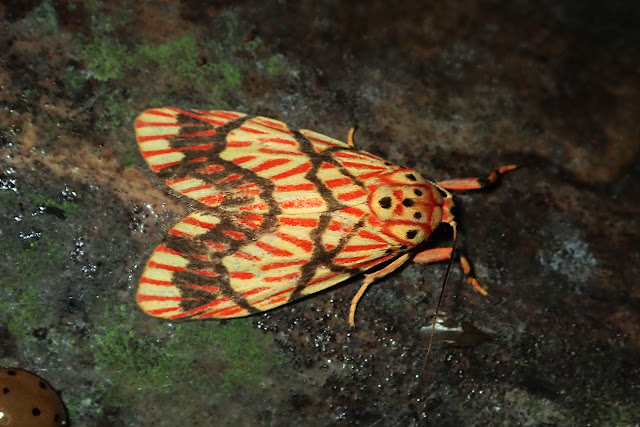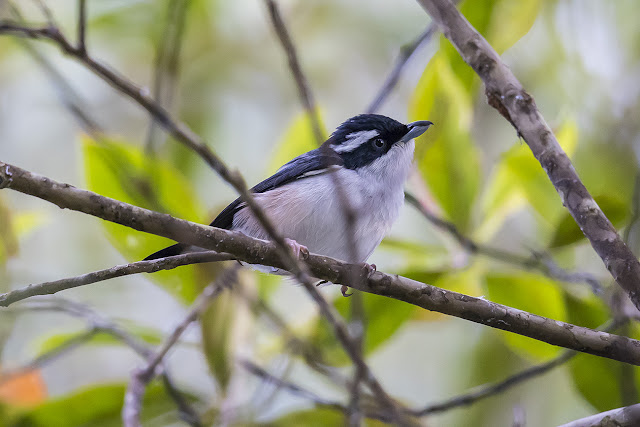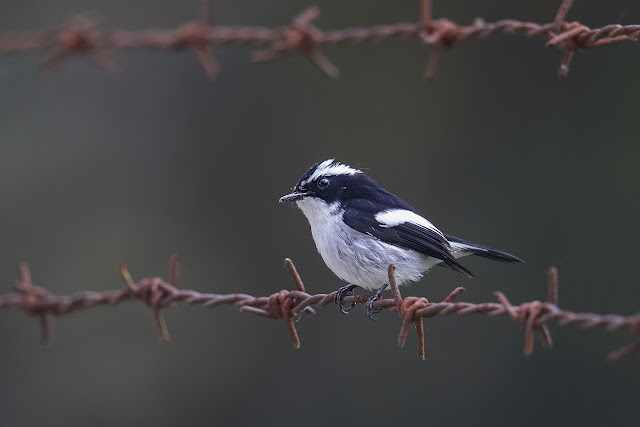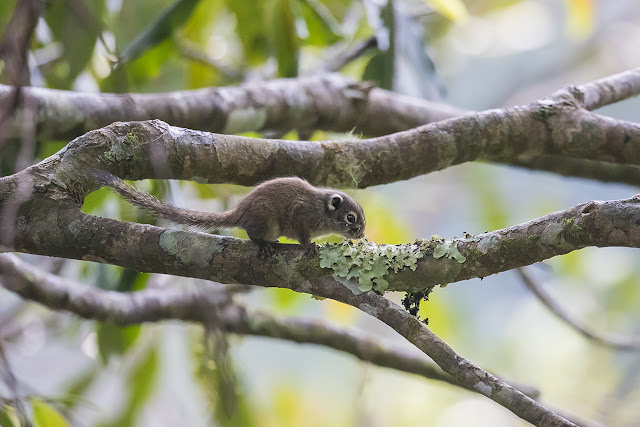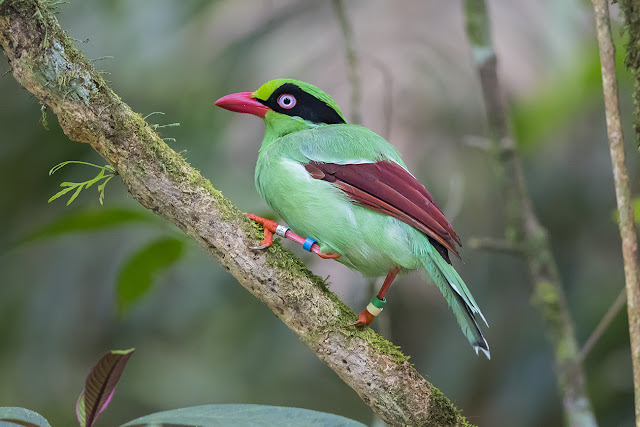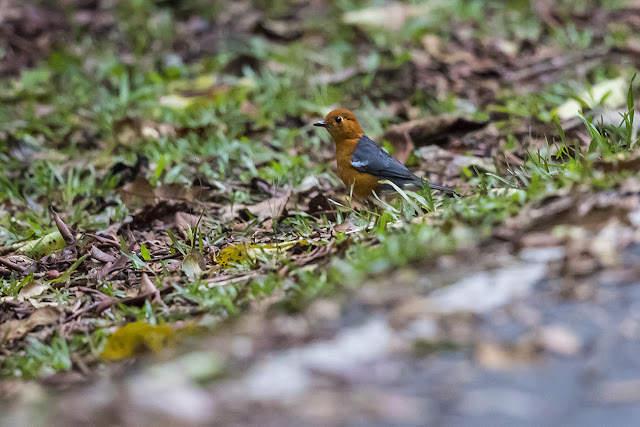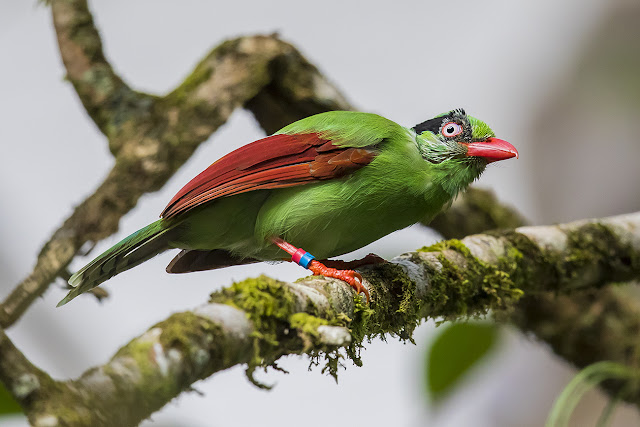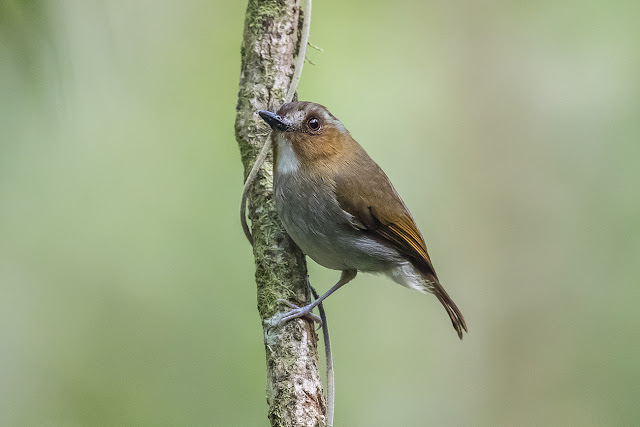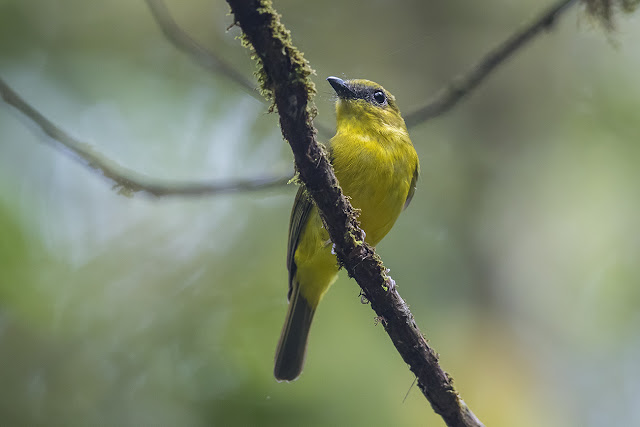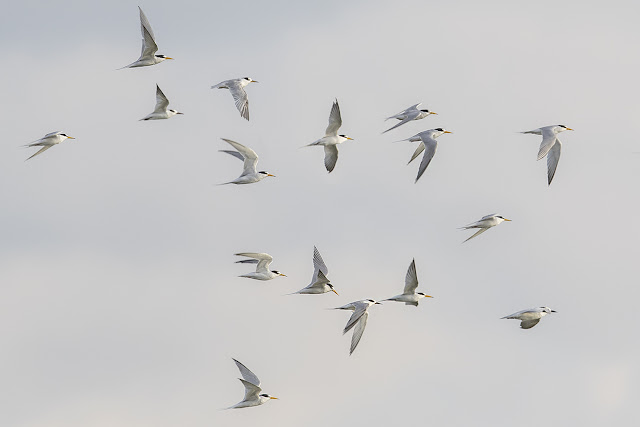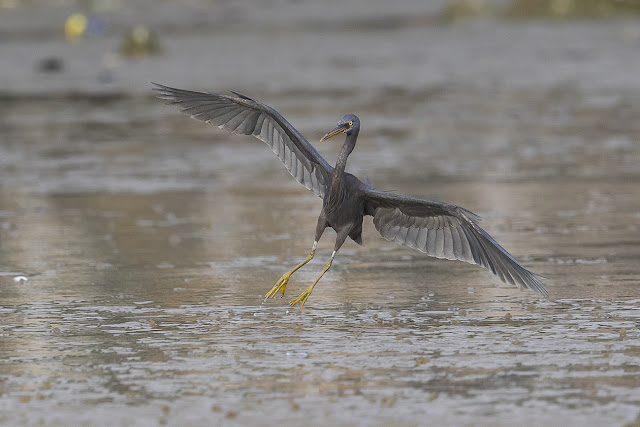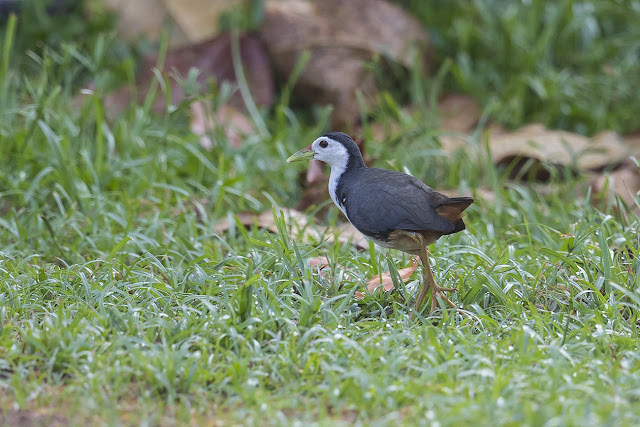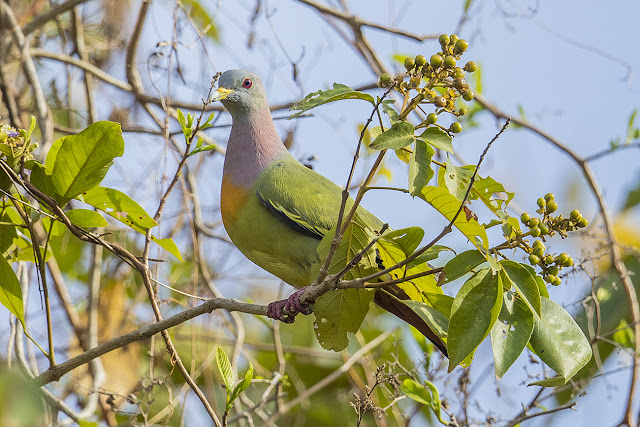Whitehead's Trogon - my personal top target of the trip
Despite having been to Kinabalu National Park twice already, I was still missing the Whitehead’s Trogon, one of the most sought after bird within the ‘whitehead’s trio’. My parents and I decided to go on a short trip together, initially we planned on heading to Okinawa, but since my dad have yet to see any of the montane endemics of Borneo, a trip to Mount Kinabalu seemed more attractive and I get another chance to catch up with my nemesis bird!
Views of Mount Kinabalu
As my third visit to the tallest mountain of South East Asia, I didn't need much pre-trip study. Our plan was to fly to Kota Kinabalu and drive straight to Kinabalu National Park where we will stay for four days before heading back to Kota Kinabalu for the last day to relax and do 'touristy' things.
Day 1 - 5th May 2019
We took a morning flight to Kota Kinabalu on Sunday, everything went smoothly, we rented with Easy-Rent A Car again, their staff was waiting for us at the arrival hall. I highly recommend them for anyone visiting Sabah, their staffs are polite and helpful and cars are usually in good order. We managed to hit the road before 2pm. The drive up to Kinabalu Park HQ is straight forward and easy, we arrived at our hotel around 3:30pm.
We stayed at the Ayana Holiday Resort, a decent little hotel just few minutes drive from the park HQ. Once we dropped our luggage we drove straight to park entrance, entrance fee for non-Malayan visitor is 15RM. Our first stop was around Liwagu Restaurant, an area I’ve always found to be quite productive for common species. Sure enough a flock of Black-capped White-eyes made an appearance.
Black-capped White-eye - juvenile
Things were surprisingly quiet, with only a few birds seen well, the common Indigo Flycatcher were amongst the most ‘showy’. Other birds seen well included a Sunda Cuckooshrike and Bornean Whistlers. We had dinner at the Liwagu Restaurant before heading back to our hotel, where we heard Mountain Scops Owl in the distance.
Indigo Flycatcher
Sunda Cuckooshrike
Bornean Whistler
Mount Kinabalu is also famous for it’s huge diversity in moths. We got a taste of it during our first evening here, with an incredible variety in colours and patterns on display. Best moths were no doubt a
Sinna calospila and a
Ischyja paraplesius, both incredibly beautiful.
Sinna calospila
Ischyja paraplesius
Acolutha pictaria
Cirrhochrista brizoalis
Barsine euprepia
Barsine roseororatus
Day 2 - 6th May 2019
We headed up to Timpohon Gate at around 5:45am and arrived just after 6am. The morning mist shrouded the gate, Bornean Treepies were the first birds that showed itself. A Maroon Woodpecker showed briefly. Back near the car park area, we spotted a Dark Hawk Cuckoo. We tried looking for the Red-breasted Partridge calling nearby with little luck.
Bornean Treepie
Maroon Woodpecker
Dark Hawk Cuckoo
Once the mist lifted the trees buzzed with birds and Chestnut-crested Yuhinas were amongst the most numerous, they are probably one of the easiest montane endemic to see at Mount Kinabalu. Yellow-breasted Warblers were also active, followed by one of the best species of the morning; a pair of Mountain Blackeyes, feeding on the nectar of a red flower by the roadside.
Mountain Blackeye
A very friendly Sunda Bush Warbler was also added. Blyth’s Shrike-babblers were feeding higher up the tree but gave decent views, smart looking males are always nice to see.
Sunda Bush Warbler
Blyth's Shrike-Babbler - male
We walked up to the power station to get a better look at the birds. There a male Little Pied Flycatcher and White-throated Fantail greeted us on the fence. An Ashy Drongo also hawked for insects from the fence.
Little Pied Flycatcher - male
White-throated Fantail
Ashy Drongo - race stigmatops
Here we also saw more Chestnut-crested Yuhinas as well as many Grey-throated Minivets, both giving eye-level views. A few Golden-naped Barbet feeding on a fruiting tree opposite the power station added a bit of excitement, getting good views of this species is never guaranteed!
Chestnut-crested Yuhina
Grey-throated Minivet - male
Grey-throated Minivet - female
Golden-naped Barbet
Golden-naped Barbet - juvenile
Squirrels are the very common at Mount Kinabalu, at Timpohon Gate we saw many Low's Squirrels and a Cream-coloured Giant Squirrel.
Jentink's Squirrel
Cream-coloured Giant Squirrel
Lower down things were fairly quiet, we tried for the Whitehead’s Trogon along Silau-Silau trail without much success, we only saw a few Bornean Whistlers and Ochraceous Bulbuls, although I heard a Whitehead's Spiderhunter called a few times, it never materialised.
Ochraceous Bulbul
We ended up at Liwagu Restaurant where we saw a pair of confiding Indigo Flycatchers and found a nest of Bornean Whistling Thrush.
Indigo Flycatcher
Bornean Whistling Thrush - nest
After a late breakfast we headed back to the hotel to rest. On the way a raptor glided past over us, I was hopeful that it could be a Mountain Serpent Eagle, but was disappointed on closer inspection that it was in fact an Oriental Honey Buzzard.
Oriental Honey Buzzard
After a mid-day nap, my dad and I headed back up again while mum rested at the hotel. We focused our attention to Silau-Silau trail and 1KM to 1.5KM mark of the power station road, as this is where Whitehead’s Trogons are most likely seen. Bornean Treepies were everywhere. An endemic Eyebrowed Jungle Flycatcher by the road added a bit of excitement.
Bornean Treepie
Eyebrowed Jungle Flycatcher
A mixed feeding flock within the trail attracted our attention as we saw a few Hair-crested Drongos and Laughingthrushes. We walked into the trail and soon after I heard the distinctive call of the Whitehead’s Broadbill! While I was searching for the Broadbill, my dad suddenly said “Trogon!”. My heart nearly stopped as I ran over to get a look, sure enough a beautiful male Whitehead’s Trogon perched silently on an open branch. At around the same time the Whitehead’s Broadbill flew towards us and landed on a branch above our heads! Seeing two of the Whitehead’s trio at the same time was quite the experience!
Whitehead's Trogon - male
Whitehead's Broadbill - male
We enjoyed the presence of the Trogon for the next fifteen minutes or so, at one point it caught a caterpillar and perched very close to us, giving phenomenal views that will surely be the highlight of the trip!
Whitehead's Trogon - a dream come true!
After the Trogon melted back into the forest, we returned to the Power Station Road and encountered yet another mixed flock, consisting of Sunda Laughingthrush and Chestnut-hooded Laughingthrush. Hair-crested Drongos also showed well.
Sunda Laughingthrush
Chestnut-hooded Laughingthrush
Hair-crested Drongo
Later on a few Bornean Green Magpies came through and gave excellent views, one entertained us while it disassembled a cicada right above us.
Bornean Green Magpie
Moths that evening was not quite so exciting as previous evening, but still provided some after dinner fun. A beautiful
Omiza lycoraria being the most interesting find of all.
Omiza lycoraria
Cirrhochrista kosemponialis
Parotis laceritalis
Tinoliodes dehanna
Day 3 - 7th May 2019
We again drove up to Timpohon Gate to start our day, a Dark Hawk Cuckoo I presume to be the same bird as the day before was again near the same area, this time giving much better view without the mist. Bornean Treepies were again noisy and showed well. A few Golden-naped Barbets were again feeding in the fruiting tree. The best find was perhaps a Whitehead's Pygmy Squirrel which showed well at close range.
 Dark Hawk Cuckoo
Dark Hawk Cuckoo
Bornean Treepie
Golden-naped Barbet
Whitehead's Pygmy Squirrel
I kept trying for the Red-breasted Partridge, which I managed a quick glimpse in the end but my dad was not able to pick it up. We drove back down towards Liwagu Restaurant where an Indigo Flycatcher showed again. We decided to walk Silau-Silau trail once again, as mum had missed both the Trogon and the Broadbill the day before. Sure enough, the Whitehead's Broadbill was present near the same area, this time perched for as long as we wished. When we exited the trail we ran into a group of birders from Beijing, we were even able to show them the bird while it remained there!
Indigo Flycatcher
Whitehead's Broadbill - male
Things were dead quiet afterwards, so we decided to go for an early lunch at Ranau. Before we hit the road we stopped at the main entrance to look at the nests of Plume-toed Swiftlets. These swiftlets were once thought to be the endemic Bornean Swiftlets but had since been confirmed to be just Plume-toed. Bornean Swiftlets supposedly resides higher up, so it and the Friendly Bush Warbler maybe my next target here!
Plume-toed Swiftlet
After lunch and a good rest, we make our way back into the park, things were equally quiet. Few common birds showed well, a female Blyth's Shrike-Babbler in particular. Near the parking area of Timpohon Gate we saw two species of endemic squirrels, including Bornean Black-banded Squirrel and Bornean Mountain Ground Squirrel.
Blyth's Shrike-Babbler - female
Bornean Black-banded Squirrel
Sunda Tree Squirrel
Lower down the Power Station Road we had a Black-sided Flowerpecker, a species that was quite easy on my previous visits, where they will feed on the Medinella berries, this time I only saw them high up in the trees. A brief walk into the Silau-Silau trail was not particularly productive other than the same Whitehead's Broadbill AGAIN! A few Mountain Leaf Warblers were about the only birds photographable before dark.
Black-sided Flowerpecker
Whitehead's Broadbill - again...
Mountain Leaf Warbler - race kinabaluensis
Mothing was yet again quite productive that evening, with a
Eupanacra psaltria hawk moth,
Omiza herois and a
Ischyja hemiphaea being highlights.
Eupanacra psaltria
Omiza herois
Ischyja hemiphaea
Cerura malaysiana
Belciana biformis
Daddala lucilla
Monodecus admirandus
Urapteroides astheniata
Day 4 - 8th May 2019
Our last morning at Kinabalu National Park started with a pair of Orange-headed Thrush just before sun came out, it was still quite dark when the pair are out feeding by the roadside. A pair of Maroon Woodpeckers showed briefly.
Orange-headed Thrush - race aurata
Maroon Woodpecker
Down near Liwagu Restaurant, a few Bornean Green Magpies showed exceptionally well. We walked through Silau-Silau trail again, hoping to catch the Trogon before we leave but came up empty handed, the trail however was quite productive, giving us good views of Snowy-browed Flycatcher, Eyebrowed Jungle Flycatcher and Bornean Whistler.
Bornean Green Magpie
Snowy-browed Flycatcher - male
Eyebrowed Jungle Flycatcher
Bornean Whistler
A Bornean Forktail gave us a glimpse before it fluttered off further up the stream. The same male Whitehead's Broadbill was found yet again on the exact same tree as the day before, by this time I suspect it is guarding a nest nearby, although I looked for the nest without much success. We also added a male White-browed Shortwing, although it was too quick for a photo, we had decent views of it.
Bornean Forktail
Whitehead's Broadbill - one last time!
Before we left the park we had breakfast at the Liwagu Restaurant, where we saw a male Temminck's Sunbird, the pair of Indigo Flycatcher and a flock of Chestnut-crested Yuhina.
Temminck's Sunbird - male
Indigo Flycatcher
Chestnut-crested Yuhina
We checked out by 11am and started our drive back into Kota Kinabalu. Traffic was pretty good and we arrived at the Shangri-La Tanjung Aru at around 1:30pm. The resort is very comfortable and is everything you can imagine of a seaside hotel, completed with it's very own private beach. We wasn't keen to do any birding in the heat, so we rested in our room.
At around 4pm when the heat subsided, we saw a large flock of terns outside our window, my dad and I went out to investigate, to our surprise they were nearly all Little Terns! There were a few Whiskered Terns mixed in with the flock.
Terns at Tanjung Aru Beach
Jellyfish found along the beach
We walked out the the main beach to get some closer photos. The terns were resting along the edge of the water and were fairly approachable.
Little Tern
Whiskered Tern - non-breeding
There were also a few Pacific Reef Egrets feeding in the shallows which put on quite a show for us. That evening we even added a Rufous Night Heron by the beach, although we were unable to get a photo of that, it was a great addition to our trip.
Pacific Reef Egret
The incredible sunset at the resort was also an added bonus.
Day 5 - 9th May 2019
Tanjung Aru Beach and nearby Taman Prince Philip is of course itself quite a decent birding spot, I've visited every time I come to Kota Kinabalu and it never seized to surprise me. The main attraction is no doubt the Blue-naped Parrot which are quite common in this area, although they supposedly introduced here, the fact that they are decreasing in their natural range in the Philippines make this feral population itself quite important. We saw plenty of these colourful parrots flying around the park.
Blue-naped Parrot
The other parrot that is quite common here is the Long-tailed Parakeet, small flocks of these can be seen flying around and often feeding on palm fruits. We even caught a pair mating! Asian Glossy Starlings also seemed to like the palm fruits and we saw plenty feeding with the Parakeets.
Long-tailed Parakeet
Long-tailed Parakeet - female
Asian Glossy Starling
Common Ioras and Pied Trillers are both common birds here and not difficult to see. A few White-breasted Waterhens were seen along the edge of the park. Dollarbirds can be found perch on top of dead trees here in the park.
Common Iora
Pied Triller - male
White-breasted Waterhen
Dollarbird
White-breasted Woodswallows are very common in the park, we saw a juvenile constantly begging for food up in the tree. Green Imperial Pigeons were hard to miss, I managed to find one sitting on a nest with a single chick! Pink-necked Green Pigeons are also very common here, although getting a good view is not always easy.
White-breasted Woodswallow
Green Imperial Pigeon
Pink-necked Green Pigeon
A few Ashy Tailorbirds were seen, followed by a female Olive-backed Sunbird and later a Brown-throated Sunbird. It was a pleasant morning walk before the weather gets really hot.
Ashy Tailorbird
Olive-backed Sunbird - female
Brown-throated Sunbird - female
Later on the day we also added a Sunda Pygmy Woodpecker at the resort's car park. I did not have my camera with me, luckily my dad was carrying with him his Canon SX60 HS, which I managed a half decent shot of what was my closest encounter with this species to date!
Sunda Pygmy Woodpecker
In the afternoon we strolled around Kota Kinabalu, walking around a few of the tourist attractions, including the Atkinson Clock Tower, supposedly the oldest standing structure of Kota Kinabalu, built in 1905. We also strolled the famous Gaya Street and sampled many Malaysian food. This was actually the first time I walked around Kota Kinabalu city centre despite my many visits to the city!
Atkinson Clock Tower
Wisma Intiutama
Gaya Street
We flew out of Kota Kinabalu very early the next day, as I was unable to get tickets for the afternoon flight. Overall, this trip was far more relaxed than my previous trips to Sabah, as this was aimed as a family/birding trip. Birds were not particularly active at Kinabalu National Park compared to my previous visit on the same month, perhaps something to do with the dry weather, but I am glad my main target Whitehead's Trogon showed up this time, together with unbelievable views of the Whitehead's Broadbill, I will say this short trip was well worth it.
For first time travellers I recommend a longer trip so you get more chances for the targets and endemics, although being such an accessible area it is not difficult to return once in a while to catch up with all the awesome species at Kinabalu National Park.
Field Guide used : 'Phillips' Field Guide to the Birds of Borneo' - third edition
Mobile Plan : You can get a one week 4G Plus plan at the airport for around 20RM
Car Rental : We used Extra Rent-a-Car, which I've used a few times already, staff are very friendly and they can pick up the car other than airport, I highly recommend them. website :
http://www.e-erac-online.com/
Accommodation : For Kinabalu National Park we stayed at the Ayana Holiday Resort, which we booked through online, it is a fairly simple but nice little hotel, only a minute drive away from the park entrance. For Kota Kinabalu we stayed at Shangri-La Tanjung Aru, not a cheap hotel but worth the price and very comfortable, also very close to Taman Prince Philip therefore good for birding.










































